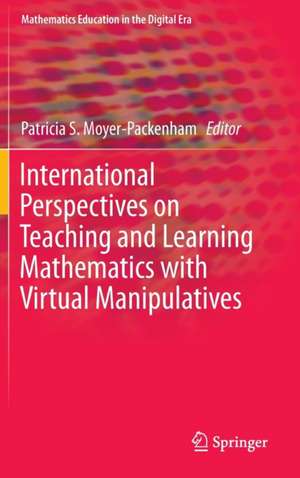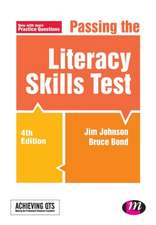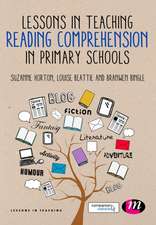International Perspectives on Teaching and Learning Mathematics with Virtual Manipulatives: Mathematics Education in the Digital Era, cartea 7
Editat de Patricia S. Moyer-Packenhamen Limba Engleză Hardback – 28 iun 2016
| Toate formatele și edițiile | Preț | Express |
|---|---|---|
| Paperback (1) | 643.34 lei 6-8 săpt. | |
| Springer International Publishing – 31 mai 2018 | 643.34 lei 6-8 săpt. | |
| Hardback (1) | 649.54 lei 6-8 săpt. | |
| Springer International Publishing – 28 iun 2016 | 649.54 lei 6-8 săpt. |
Din seria Mathematics Education in the Digital Era
- 15%
 Preț: 642.68 lei
Preț: 642.68 lei - 24%
 Preț: 739.44 lei
Preț: 739.44 lei - 18%
 Preț: 782.42 lei
Preț: 782.42 lei - 15%
 Preț: 644.82 lei
Preț: 644.82 lei - 18%
 Preț: 1127.15 lei
Preț: 1127.15 lei - 18%
 Preț: 959.36 lei
Preț: 959.36 lei - 18%
 Preț: 952.26 lei
Preț: 952.26 lei - 24%
 Preț: 804.93 lei
Preț: 804.93 lei - 18%
 Preț: 990.93 lei
Preț: 990.93 lei -
 Preț: 438.10 lei
Preț: 438.10 lei - 18%
 Preț: 953.03 lei
Preț: 953.03 lei - 18%
 Preț: 889.92 lei
Preț: 889.92 lei - 24%
 Preț: 875.83 lei
Preț: 875.83 lei - 24%
 Preț: 752.35 lei
Preț: 752.35 lei -
 Preț: 360.15 lei
Preț: 360.15 lei - 15%
 Preț: 649.06 lei
Preț: 649.06 lei - 20%
 Preț: 573.77 lei
Preț: 573.77 lei -
 Preț: 394.29 lei
Preț: 394.29 lei -
 Preț: 389.88 lei
Preț: 389.88 lei - 18%
 Preț: 1117.50 lei
Preț: 1117.50 lei - 18%
 Preț: 1112.78 lei
Preț: 1112.78 lei
Preț: 649.54 lei
Preț vechi: 764.17 lei
-15% Nou
Puncte Express: 974
Preț estimativ în valută:
124.31€ • 129.30$ • 102.62£
124.31€ • 129.30$ • 102.62£
Carte tipărită la comandă
Livrare economică 14-28 aprilie
Preluare comenzi: 021 569.72.76
Specificații
ISBN-13: 9783319327167
ISBN-10: 331932716X
Pagini: 425
Ilustrații: VIII, 345 p. 114 illus.
Dimensiuni: 155 x 235 x 21 mm
Greutate: 0.67 kg
Ediția:1st ed. 2016
Editura: Springer International Publishing
Colecția Springer
Seria Mathematics Education in the Digital Era
Locul publicării:Cham, Switzerland
ISBN-10: 331932716X
Pagini: 425
Ilustrații: VIII, 345 p. 114 illus.
Dimensiuni: 155 x 235 x 21 mm
Greutate: 0.67 kg
Ediția:1st ed. 2016
Editura: Springer International Publishing
Colecția Springer
Seria Mathematics Education in the Digital Era
Locul publicării:Cham, Switzerland
Cuprins
SECTION 1: Frameworks and Definitions.- 1. Revisiting the Definition of a Virtual Manipulative. Patricia S. Moyer-Packenham & Johnna J. Bolyard (United States).- 2. Artifact-Centric Activity Theory – A Framework for the Analysis of the Design and Use of Virtual Manipulatives. Silke Ladel & Ulrich Kortenkamp (Germany).- 3. The Modification of Attributes, Affordances, Abilities, and Distance for Learning Framework and its Applications to Interactions with Mathematics Virtual Manipulatives. Stephen I. Tucker (United States).- 4. Physical and Virtual Manipulatives: What is “Concrete”? Julie Sarama and Douglas H. Clements (United States).- 5. Manipulatives, Diagrams, and Mathematics: A Framework for Future Research on Virtual Manipulatives. Helena P. Osana and Nathalie Duponsel (Canada).- SECTION 2: Research and Design.- 6. Fingu – A Game to Support Children’s Development of Arithmetic Competence: Theory, Design and Empirical Research. Ingemar Holgersson, Wolmet Barendregt, JonasEmanuelsson, Torgny Ottosson, Elisabeth Rietz & Berner Lindstrom (Sweden).- 7. Developing Virtual Mathematics Manipulatives: The SAMAP Project. Erol Karakirik (Turkey).- 8. Enhancing Mathematical Skills through Interventions with Virtual Manipulatives. Annemie Desoete, Magda Praet, Claire Van de Velde, Brigitte De Craene, & Edwin Hantson (Belgium).- 9. Influence of Prior Knowledge and Teaching Approaches Integrating Non-Routine Worked Examples and Virtual Manipulatives on the Performance and Attitude of Fifth-Graders in Learning Equivalent Fractions. Chun-Yi Lee & Ming-Jang Chen (Taiwan).- 10. The Role of Virtual Manipulatives in High School Students’ Understanding of Geometric Transformations. Hilal Gulkilik (Turkey).- SECTION 3: Tools for Research.- 11. Geometry and iPads in Primary Schools: Does Their Usefulness Extend beyond Tracing an Oblong? Kevin Larkin (Australia).- 12. Selection of Apps for Teaching Difficult Mathematics Topics: An Instrument to Evaluate Touch-Screen Tablet and Smart Phone Mathematics Apps. K. Aryee, George Gadanidis, Immaculate K. Namukasa, V. Sarina, & S. Scucuglia (Canada & Brazil).- 13. Ambitious Teaching: Designing Practice-Based Assignments for Integrating Virtual Manipulatives into Mathematics Lessons. Jennifer M. Suh (United States).- 14. Developing an Interactive Instrument for Measuring Teachers’ Professionally Situated Knowledge in Geometry and Measurement. Agida G. Manizade & Dragana Martinovic (United States & Canada).
Textul de pe ultima copertă
This book explores terminology, frameworks, and research being conducted worldwide on virtual manipulatives. It brings together international authors who provide their perspectives on virtual manipulatives in research and teaching. By defining terminology, explaining conceptual and theoretical frameworks, and reporting research, the authors provide a comprehensive foundation on the study and use of virtual manipulatives for mathematics teaching and learning. This foundation provides a common way for researchers to communicate about virtual manipulatives and build on the major works that have been conducted on this topic. By discussing these big ideas, the book advances knowledge for future research on virtual manipulatives as these dynamic tools move from computer platforms to hand-held, touch-screen, and augmented platforms.
Caracteristici
Provides an international perspective on virtual manipulatives in research and teaching Explores terminology and frameworks to help enhance researchers’ communication on the topic Offers a platform for discussion of the worldwide research conducted on virtual manipulatives Indicates new directions for future research on virtual manipulatives Includes supplementary material: sn.pub/extras














